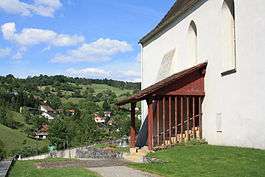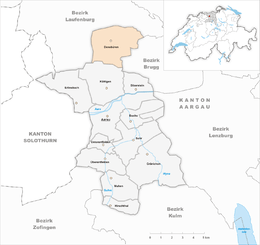Densbüren
| Densbüren | ||
|---|---|---|
 | ||
| ||
 Densbüren | ||
|
Location of Densbüren  | ||
| Coordinates: 47°27′N 8°03′E / 47.450°N 8.050°ECoordinates: 47°27′N 8°03′E / 47.450°N 8.050°E | ||
| Country | Switzerland | |
| Canton | Aargau | |
| District | Aarau | |
| Area[1] | ||
| • Total | 12.51 km2 (4.83 sq mi) | |
| Elevation | 481 m (1,578 ft) | |
| Population (Dec 2015[2]) | ||
| • Total | 702 | |
| • Density | 56/km2 (150/sq mi) | |
| Postal code | 5026 | |
| SFOS number | 4004 | |
| Localities | Densbüren, Asp | |
| Surrounded by | Herznach, Küttigen, Oberhof, Thalheim, Wölflinswil, Zeihen | |
| Website |
www SFSO statistics | |
Densbüren is a municipality in the district of Aarau of the canton of Aargau in Switzerland.
History
Densbüren is first mentioned in the 14th century as Tensbuirron. In 1426 it was mentioned as Teinspuiren.[3]
Geography
Densbüren has an area, as of 2006, of 12.6 km2 (4.9 sq mi). Of this area, 39.2% is used for agricultural purposes, while 55.7% is forested. Of the rest of the land, 4.8% is settled (buildings or roads) and the remainder (0.2%) is non-productive (rivers or lakes).[4]
The municipality is located in the Aarau district on the northern slope of the Staffelegg Pass, a regionally important pass over the Jura Mountains. It consists of the linear village of Densbüren and the hamlets of Asp.
Coat of arms
The blazon of the municipal coat of arms is Argent bordered Gules a Pine Tree Vert issuant from Coupeaux of the same.[5]
Demographics
Densbüren has a population (as of 31 December 2015) of 702.[6] As of 2008, 7.7% of the population was made up of foreign nationals.[7] Over the last 10 years the population has decreased at a rate of -4.9%. Most of the population (as of 2000) speaks German (98.2%), with Albanian being second most common ( 0.4%) and Serbo-Croatian being third ( 0.3%).[4]
The age distribution, as of 2008, in Densbüren is; 56 children or 7.8% of the population are between 0 and 9 years old and 110 teenagers or 15.4% are between 10 and 19. Of the adult population, 83 people or 11.6% of the population are between 20 and 29 years old. 79 people or 11.0% are between 30 and 39, 126 people or 17.6% are between 40 and 49, and 107 people or 15.0% are between 50 and 59. The senior population distribution is 74 people or 10.3% of the population are between 60 and 69 years old, 51 people or 7.1% are between 70 and 79, there are 26 people or 3.6% who are between 80 and 89,and there are 3 people or 0.4% who are 90 and older.[8]
As of 2000, there were 25 homes with 1 or 2 persons in the household, 98 homes with 3 or 4 persons in the household, and 135 homes with 5 or more persons in the household. The average number of people per household was 2.62 individuals.[9] In 2008 there were 151 single family homes (or 49.8% of the total) out of a total of 303 homes and apartments.[10]
In the 2007 federal election the most popular party was the SVP which received 52.4% of the vote. The next three most popular parties were the FDP (10.5%), the SP (10.3%) and the CVP (8%).[4]
The entire Swiss population is generally well educated. In Densbüren about 77.1% of the population (between age 25-64) have completed either non-mandatory upper secondary education or additional higher education (either University or a Fachhochschule).[4] Of the school age population (in the 2008/2009 school year), there are 44 students attending primary school in the municipality.[9]
The historical population is given in the following table:[3]
| Historical population | ||
|---|---|---|
| Year | Pop. | ±% |
| 1764 | 469 | — |
| 1798 | 666 | +42.0% |
| 1850 | 1,167 | +75.2% |
| 1900 | 934 | −20.0% |
| 1950 | 772 | −17.3% |
| 1980 | 596 | −22.8% |
| 2000 | 721 | +21.0% |
Heritage sites of national significance
The ruined castle of Urgiz Castle is listed as a Swiss heritage site of national significance.[11]
Economy
As of 2007, Densbüren had an unemployment rate of 1.42%. As of 2005, there were 81 people employed in the primary economic sector and about 28 businesses involved in this sector. 98 people are employed in the secondary sector and there are 10 businesses in this sector. 88 people are employed in the tertiary sector, with 20 businesses in this sector.[4]
As of 2000 there was a total of 361 workers who lived in the municipality. Of these, 255 or about 70.6% of the residents worked outside Densbüren while 100 people commuted into the municipality for work. There were a total of 206 jobs (of at least 6 hours per week) in the municipality.[12]
Religion
From the 2000 census, 113 or 15.7% are Roman Catholic, while 529 or 73.4% belonged to the Swiss Reformed Church.[9]
References
- ↑ Arealstatistik Standard - Gemeindedaten nach 4 Hauptbereichen
- ↑ Swiss Federal Statistical Office - STAT-TAB, online database – Ständige und nichtständige Wohnbevölkerung nach institutionellen Gliederungen, Geburtsort und Staatsangehörigkeit (German) accessed 30 August 2016
- 1 2 Densbüren in German, French and Italian in the online Historical Dictionary of Switzerland.
- 1 2 3 4 5 Swiss Federal Statistical Office accessed 22-January-2010
- ↑ Flags of the World.com accessed 22-January-2010
- ↑ Swiss Federal Statistical Office - STAT-TAB, online database – Ständige und nichtständige Wohnbevölkerung nach institutionellen Gliederungen, Geburtsort und Staatsangehörigkeit (German) accessed 30 August 2016
- ↑ Statistical Department of Canton Aargau -Bereich 01 -Bevölkerung (German) accessed 20 January 2010
- ↑ Statistical Department of Canton Aargau -Bevölkerungsdaten für den Kanton Aargau und die Gemeinden (Archiv) (German) accessed 20 January 2010
- 1 2 3 Statistical Department of Canton Aargau - Aargauer Zahlen 2009 (German) accessed 20 January 2010
- ↑ Statistical Department of Canton Aargau (German) accessed 20 January 2010
- ↑ Swiss inventory of cultural property of national and regional significance 21.11.2008 version, (German) accessed 22-Jan-2010
- ↑ Statistical Department of Canton Aargau-Bereich 11 Verkehr und Nachrichtenwesen (German) accessed 21 January 2010
External links
- Commune homepage (German)
- Densbüren in German, French and Italian in the online Historical Dictionary of Switzerland.
| Wikimedia Commons has media related to Densbüren. |
